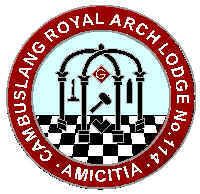It is not clear exactly when Freemasonry began but it is widely accepted to have originated from the stonemason trade guilds of the Middle Ages, referred to as Incorporated Trades or Crafts.
The term “incorporated” comes from the fact that these various craft organizations held Royal charters, or ‘Seals of Cause’ which allowed them to work exclusively within the Royal Burghs in the Middle Ages. The language and symbols used in Freemasonic rituals today come from these older craft bodies.
The earliest use of the term Freemason dates from around 1390 but referred purely to operative members. Prior to the formalization of Freemasonry as we know it however, Scotland was already beginning to see a shift during the 17th century where more and more nonoperative members were joining the old trade institutions. Throughout the 17th, 18th and 19th centuries in particular, the fraternity expanded across Europe and the Americas leading to the position today where you will find lodges globally.
The original Masonic guilds were ‘operative’, in other words, concerned with the operating of the craft of stonemasonry. Modern Masons are ‘allegorical’ in that the rituals and ceremonies are symbolic. The Masonic lodges today are about mutual fellowship, support and charitable work.
SCOTTISH FREEMASONRY IN THE AGE OF ENLIGHTENMENT
Some have referred to the 18th century as the age of Freemasonry. It was certainly the age of Fraternalism with many new organisations promoting mutual aid and encouragement. The 18th century was very much a time of change, the age of ‘Enlightenment’. With this change, however, came revolution. Some Freemasons on the continent became even more secretive than previously to escape the effects of persecution from the authorities. Handshakes and other modes of recognition which had been used by the trade crafts to identify each other became even more important as did the ideals of equality and fraternity. Many historical Enlightenment figures were Freemasons who became involved on both sides of the Jacobite uprisings and on both sides of the French and American revolutions. Robert Burns became a freemason in 1781, age 23. Marie Roberts, in “Burns and the Masonic Enlightenment” states that Freemasonry not only spoke out for the ideals of ‘liberty, fraternity, equality’, but was also responsible for the creation of nationalistic feelings and fervour, as a number of Freemasons played prominent roles in the American and French Revolutions.
SCOTTISH FREEMASONRY – AN ORIGINAL PERSPECTIVE
The Grand Master of the Scottish constitution bears the unique title Grand Master Mason, an office which has been held by distinguished members of Scottish society.
Unlike other regular Masonic jurisdictions, all members, of whatever rank, are addressed simply as “Brother”. The usual and more complex masonic titles are used in Scotland, but attach to the office, not the individual. This differentiates Scottish Freemasonry from much of the other traditions and keeps to the true teaching of the Fraternity and being on the level.
Lodges under the Scottish Constitution are sovereign bodies in their own right, with a considerable degree of control over their own affairs. Many Lodges pre-existed Grand Lodge, all zealously guarding their traditions, and were permitted to retain their own procedures, regalia, and distinctive rituals. Having accepted the principle of independence of old Lodges, it was impossible to deny Lodges founded after 1736 the same level of independence. Of course the rituals must contain the principal points of each degree, but the scope for elaboration is considerable, with numerous interesting variations. Since Scottish Lodges have the right to choose the colours of the Lodge regalia, meetings are very colourful, especially if visitors from other Lodges are present.
Today, Scottish Freemasonry continues to flourish and grow, offering a unique and original perspective on Freemasonry that has survived for over 400 years and with a membership that is spread across the 32 Provinces in Scotland and the 28 Districts worldwide. As the world is changing, Scottish Freemasonry continues to preserve its traditions and rich heritage while keeping a focus on staying up to date with the changes that affect and influence its membership.

